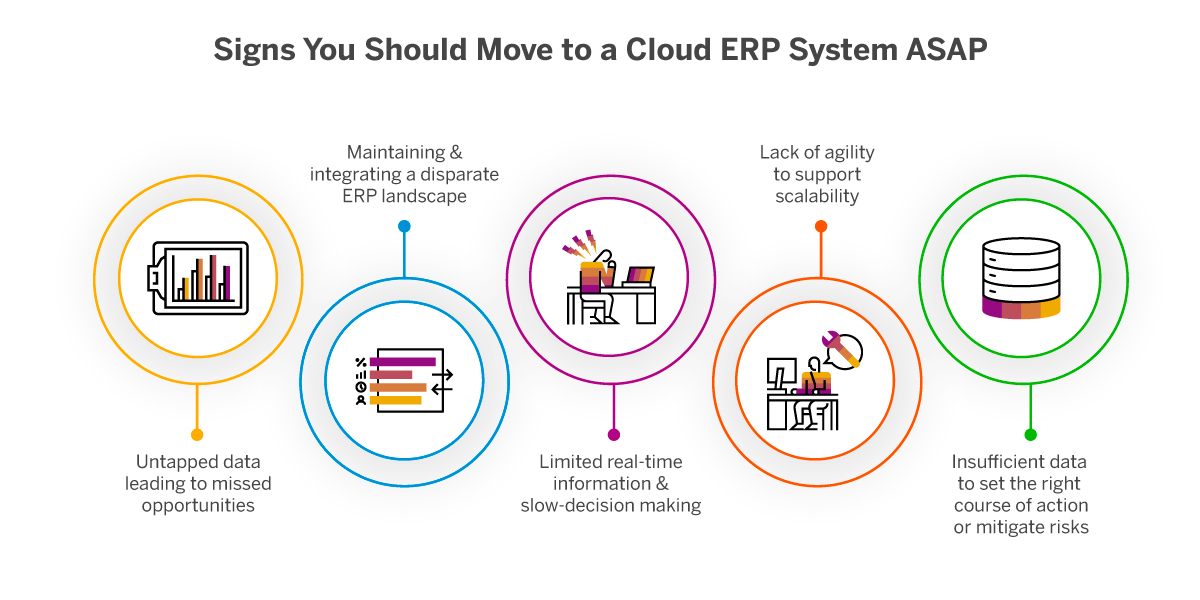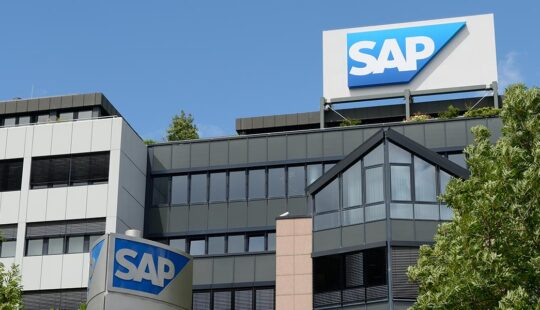With large, well-known enterprises on one end of the competitive landscape and rising startups emerging on the other, growing businesses face an interesting dilemma.
Every single competitor is working to deliver the best products, 24 x 7 services, and responsive customer experiences. But at a time when time, capital, and resources are extraordinarily tight, growing companies need to make a permanent shift in their ERP strategy to address evolving needs and fuel sustainable growth. Take, for example, this research finding from IDC. Although revenue growth is understandably a top priority for 41% of surveyed small and medium-size businesses, 35.4% identified legacy applications and custom code as top barriers to meeting that goal.1 And in most cases, the most problematic technology is an ERP system implemented years ago as a system of historical records, outdated insights, and little to no visibility into future opportunities and risks.

So how do you know whether your business is part of the 35.4% that has outgrown legacy ERP? According to IDC’s Mickey North Rizza, program vice president of Enterprise Applications and Digital Commerce, growing businesses should watch out for any of the five warning signs.
Sign #1: Massive data left unused
Every organization collects large volumes of data every day, internally and externally. But when growing companies move from a legacy ERP to a more intelligent one, they are usually caught off guard when they see how much valuable, much-needed intelligence is left unused. Worse yet, frustration across the leadership team intensifies when it considers opportunities missed from not tapping that wealth of knowledge.
Understanding the importance of getting the most value from all data, So this quickly realized that its legacy ERP couldn’t generate the comprehensive insight needed to increase profitability and gain a substantial edge over the competition. The consulting firm, which helps clients digitalize their operations throughout Spain and beyond, gained total visibility over its customer projects – standardizing processes, increasing profitability, simplifying system maintenance, and accelerating the introduction of new innovations.
Sign #2: Disconnected user experiences
Connecting employees, suppliers, and customers to relevant resources and data points is critical to meeting everyone’s expectations. Unfortunately, most organizations have spent years developing and adopting different ERP tools, such as custom functionality and spreadsheet-driven analytics. In return, the ERP landscape becomes so overly complex that applications, processes, and data are challenging to maintain and integrate.
Most times the only way to unravel these challenges is to start with a clean slate. For Shenzhen Huasheng Home Furnishing Group Co. Ltd., this line of thinking led to the implementation of a cloud-based intelligent ERP.
To energize rapid growth, the home furnishing holding group enabled responsive order-based production, visual traceability of product quality, an integrated management center powered by personnel, data, and target process and real-time financial online processing. Furthermore, IT costs were reduced with the ease, efficiency, and standards of a cloud-based intelligent ERP while engaging employees in innovative, well-rounded work.
Sign #3: Delayed actions and process bottlenecks
Every employee wants to think, understand, and move swiftly with data-driven insights and confident decision-making. However, most legacy ERP systems are batch-oriented, limiting real-time information availability even if an add-on is designed to augment the system with real-time data.
Data timing is of the utmost importance, especially when managing the finances of a high-pressure business like that of Nexmos Co. Ltd. The expanding bio-venture research organization streamlined its finance processes by enabling automatic updates between a cloud ERP solution and its banking software and automating the reporting of business partner details to tax authorities.
Sign #4: Inflexibility to scale operations up or down on demand
Businesses that respond to the ebbs and flows of operational performance and market demand with balance and ease are well-positioned to lower costs, optimize employee engagement, and yield a high rate of customer satisfaction. When using an ERP that is intelligent enough to keep up with every twist and turn, organizations can scale business needs – such as production capacity, pricing models, and workforce augmentation – with precision.
Powell Electronics has seen firsthand the value of replacing a highly customized business solution with a modern ERP from a trusted provider. The specialty business of high reliability, harsh environment connector design, manufacturing, and supply chains gained dramatic efficiencies that will serve as the foundation for scaling operations to support sales growth set to double current revenue within five years.
Sign #5: Decisions that routinely lead to less-than-optimal outcomes
Without the effective use of Big Data, companies can get swallowed up by their competition quickly. They must make decisions by sensing what is happening now and what may occur in the future and setting the right course of action to take on opportunities and mitigate risk.
Without access to a real-time, complete data set, guiding the business is extraordinarily tough. Instead, people require a combination of transactional ERP data and data from the applications of other organizations and third parties to feed their analytics tools and derive insights that inspire timely and productive action.
Take, for example, Dallant. The parent company of a food industry group implemented a modern ERP to increase its steady annual growth sustainably, ensuring social, economic, and environmental responsibility. With company-wide integration and oversight, its workforce engages in better decision-making at all levels.

Is it time to move to Intelligent ERP?
Ultimately, having the right technology goes in hand with moving a business forward proactively, automatically, and in real time with situational intelligence and data-driven analysis. And when your operations run with such efficiency and effectiveness, your organization has the strength of its employees, suppliers, and customers behind it as it conquers the next challenge as an interconnected team. That’s the beauty of moving from a legacy ERP to Intelligent ERP – gaining critical capabilities to ignite present-day and future growth.
To learn more on how Intelligent ERP systems deliver critical business capabilities that current systems lack, download the recent IDC Technology Spotlight.



